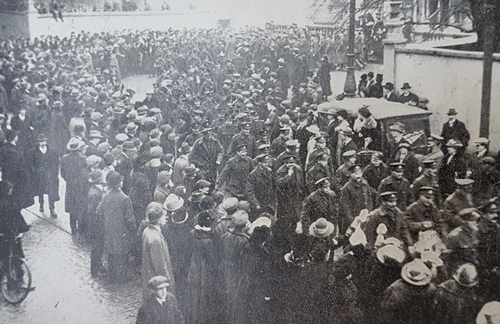British-funded homes for ex-servicemen in Ireland will not compete with other housing plans
Dublin, 10 April 1923 - The British treasury has allocated £1.5m to the housing of ex-servicemen in Ireland.
Yet to be decided is the breakdown of the allocation between the governments of Northern Ireland and the Free State, but it is understood that the goal remains the construction of 3,672 cottages; 2,626 in the Free State and 1,046 in the Six Counties.
While the Irish Free State will not take responsibility for undertaking the work involved in the scheme, it is willing for a team of trustees to oversee it. As a result, five trustees are to be appointed, three by the British Secretary of State and one each by the President of the Executive Council of the Free State and the Prime Minister of Northern Ireland. However, the money allocated to the scheme is currently suspended pending certificates which, under the Irish Free State (Consequential Provisions) Act, requires that such legislation has been passed both by the parliaments of the Free State and Northern Ireland to enable a trust to acquire and hold the land that is to be vested in it.
Demand for cottages among ex-servicemen is considerable, particularly on the part of those currently housed in city and town tenements. It is envisaged that each cottage provided in rural districts will come with a quarter or half acre plot, with the plot and dwelling rented weekly and the taxes covered by the occupant.
It is understood that the scheme for housing ex-servicemen will in no way conflict or compete with housing plans developed by Dublin Corporation.
In a related development, the Association for the Housing of the Very Poor Ltd., held its annual meeting last week at which the difficulties in meeting the vast housing demand were highlighted.
The President of the Association, Sir Lambert Ormsby, pointed out that over the last quarter century there had been a number of developments which had served to limit the desired rate of progress. Mr. Ormsby pointed to the huge increase in labour and material costs, as well as to the ‘staggering rise’ in municipal rates and the property tax.
Taken together, these costs had thwarted the efforts of the Association and made it extremely risky, he said, to build new dwellings in Dublin. As matters stood, the Association needed more shareholders or donations because, although they already had a large plot of land cleared for building, without more money they would not be in position to do so given the price of labour and material. In Dublin, for instance, the price of basic bricks was £5 per 1,000, while similar bricks could be purchased in Belfast or London for just over £2.
Meanwhile, Ormsby claimed that the administration of municipal taxes in Dublin was little short of a public scandal, the high rates serving to strangle badly needed development so that houses could be built for the working classes and the very poor. According to Ormsby, he would be satisfied if the houses could be built at no profit, but there should not be any loss.
[Editor's note: This is an article from Century Ireland, a fortnightly online newspaper, written from the perspective of a journalist 100 years ago, based on news reports of the time.]





















